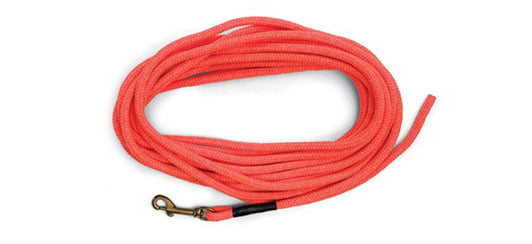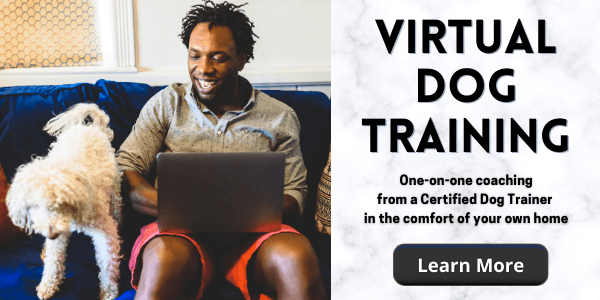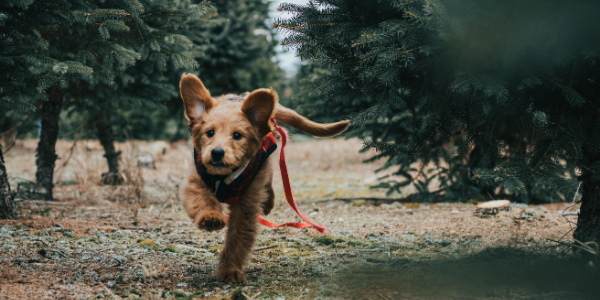
A reliable recall, or come when called, is the most important thing you should train your dog to do.
This behavior will help keep your dog safe and, at the same time, allow you to give your dog more freedom throughout their daily life.
While your dog's recall is not a substitution for keeping them on a leash or in a fenced yard, it is a training skill that could save your dog’s life.
You must teach your dog that it's worth it to come when called whenever you ask, on leash or off (outdoors or indoors). Even more important, this should be done without the use of force or pain to make it happen. You simply don't need a shock collar to train a reliable recall.
A recently published study shows that dogs trained with positive reinforcement methods outperformed dogs taught using shock collars for the come when called behavior. They learned faster and responded faster than dogs trained using aversive training methods.
There are many reasons you should avoid using shock collars altogether for training come when called (and every other dog behavior) — learn more in "Dog Training Aversives: What Are They and Why You Should Avoid Them."
Let's look at how you can teach your dog a rock-solid recall using fun, positive, and humane training techniques.
Table of Contents
Fun Recall Games
Testing Your Dog's Recall
Structured Recall Training Practice
Come When Called Around Distractions
Set Up for Recall Success
Creating a Faster Recall
Is Your Dog Ready for Off-Leash?
How to Train Your Dog to Come When Called
What You'll Need:
- A training treat pouch. I prefer this style over other pouches because it has two separate compartments inside, a full waist belt, and snaps closed to prevent treats from flying everywhere when I move around.
- Your clicker (or marker word, like "yes!" if you're not using a clicker)
- Your dog's favorite high-value training treats. The favorite amongst all Preventive Vet's office dogs is Vital Essentials freeze-dried minnows.
- A long leash. A longer lead is needed to work long-distance recalls safely. You can also simply attach multiple leashes together. (Do NOT use a retractable leash — learn why retractable leashes can be dangerous here.)
- Optional: a training whistle
Choose a Word (or Sound) for Your Dog's Recall
First, a Word About Poisoned Dog Training Cues
What is a "Poisoned" Cue?
A poisoned cue is a word that your dog has associated with something bad happening right afterward. This could be anything from losing a favorite chew when you say "drop it," to getting bathed when they hear "bath time!"
Anything that they find unpleasant, uncomfortable, or painful when used with a word or cue can become poisoned.
The come command is the most commonly poisoned cue in dog training that I see with my clients. Why? Think about it from the dog's point of view — you call them to come, and here's what often happens:
- They have to leave the dog park
- They get put in their crate
- They get scolded or smacked for a potty accident (please never do this!)
- For dogs previously trained on a shock collar, they anticipate a shock after hearing the come command
Think back over the last few days. When did you say “come” to your dog? Did the dog’s coming to you result in something good or something bad for them?
Do you notice a change in their body language when they hear the word come? Does this body language indicate stress, or does it indicate excited anticipation? Did they come bounding back to you, loose and happy? Or do they slowly slink your way?
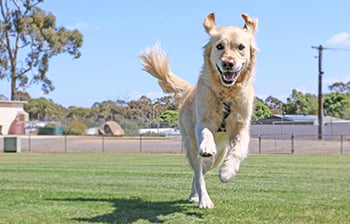
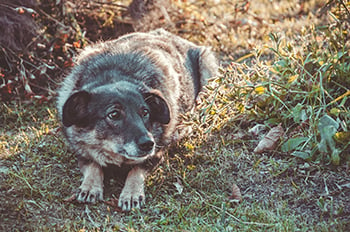
What to do if Your Dog Has a Poisoned Cue
If you think your dog has a poisoned “come” cue, there is a simple fix — change the word you use to call them to come to you! If you’ve been using “come,” other common cues are “Here” or “To Me,” but any word can be used, as long as you’re consistent.
PRO TIP: If your dog just ignores your current come cue, but it's not necessarily "poisoned," you can also restart their recall training using a new and different word.
Some dogs have simply learned that the word means nothing for them, good or bad. This is much more common than a truly poisoned cue. In the words of Marie Kondo, the word just doesn't "spark joy!"
Common Words to Use For Your Dog's Recall
Pick a word you will use for your dog's recall cue. It really can be any word you'd like, but here are the most common I've heard:
- "Come"
- "Here"
- "To Me"
- "Hurry"
- Some people use "Touch," so that their dog comes to them and targets their hand to complete the behavior.
- Instead of a word, you can use a whistle. This is an excellent option for people who might not be able to yell very loudly or are soft-spoken.
Pro Tip: The regular come when called cue is different than what your emergency recall cue will be. It's a very important cue and it's trained differently.
Emergency recalls are heavily trained in the beginning and then maintained, but always rewarded with the highest value treat. Compared to your regular recall which uses a variety of rewards from the start, with the goal of fading out the clicker and the treats as training progresses.
Why would you need an emergency recall if your dog has a regular recall cue?
Realistically, a lot of times our own training habits mean that a dog's regular recall is not as successful around distractions as it should be. Or, in some cases, a dog has just started recall training, so the behavior is still new.
The emergency recall is a way to call a dog back in case of emergency, such as door dashing or if they take off chasing a squirrel. If you are consistent in your reliable recall training, it will eventually be just as good as your dog's emergency recall response!
Make sure everyone in your home knows to use this new word for your dog's recall. Consistency in verbal cues makes training go much easier for you and your dog. If one person says "here," and another says "come," it will get confusing to your dog (and you!).
Download and customize this cue template and put it in a high-traffic area so everyone, including your dog walker or pet sitter, is on the same page.
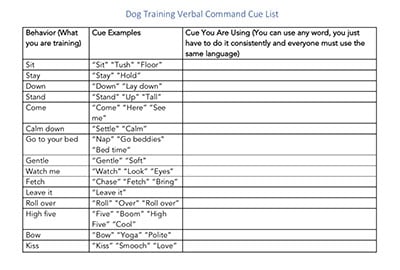 Teach Your Dog What "Come" Means
Teach Your Dog What "Come" Means
When introducing the come cue to your dog, don't say it unless they're already doing it! Your dog doesn't just know that the word "come" means to run back to you.
Here's how I introduce the come cue in training:
- Entice the dog to come towards me. I might run around like a crazy person, pat my legs or the ground, grab a squeaky toy, make kissy noises — whatever makes the dog want to come towards me.
- Say "come" just as they are about to reach me.
- Click or say "yes" (if using a marker word) as they reach me and I gently grasp their collar.
- Treat! Play! Praise!
Following these steps teaches your dog that coming to you (close enough to hold them by their collar) is called "come." I don't expect a dog who hasn't been introduced to the verbal cue to come when I call out that word.
That would be like someone saying something to me in a language I don't understand and expecting me to know what they mean.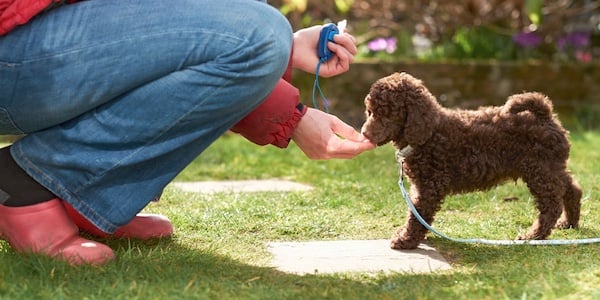
The timing of your click or marker word is crucial here. Don't click until they are completing the behavior. I consider the recall complete when I can take hold of a dog's collar, but you may decide that you want your dog's recall to be complete when they come back to you and sit.
Others might decide they are fine with their dog just returning to them and staying close, not caring what position they finish in.
I choose the collar grab as part of the recall because it gives me more control in different situations and prevents a fly-by dog. I can attach a leash or release them back to whatever they were doing.
Think about what you want your dog's come when called behavior to look like and train for that!
Real-Life Training for Come When Called
Start capturing the times your dog is naturally coming towards you to strengthen their recall cue. This will speed up your dog's training!
- At mealtimes, say "come" as they are approaching and reward them with putting their food bowl or food puzzle down for them.
- When you grab their leash and harness for a walk, and they're running to meet you at the door, say "come" and reward them with praise and getting to go for their walk.
- While playing fetch, as they're running back with their fetch toy, say "come" and reward with praise and another toss of their toy.
- Any time your dog is walking or running towards you, say "come" and reward when they get to you! Use real-life rewards like play, praise, cuddles, or toys mixed in with training treats.
Fun Games to Play to Train Your Dog to Come When Called
Puppy Ping Pong
I absolutely LOVE playing puppy ping pong. It's fun for the whole family, it helps teach the dog to respond to everyone (not just one person), and it builds up the speed of your dog's recall. You need a minimum of two people to play, but you can play with as many people as you want.
This game evolved from my childhood, where my brother and I would call the dog to come at the same time to see who she loved more ... but now I've modified it to help with recall training.
I once played this game in a puppy class, with eight owners spread throughout the training room and calling all the puppies to come at once — it was so much fun!
Watch some of the Preventive Vet team play the puppy ping pong game in this video:
How to Play Puppy Ping Pong
- Give everyone a stash of training treats and stand spread out around the room or in a fenced yard.
- Start with one person calling the dog to come. Say the cue JUST ONCE!
- Everyone else stays still and acts very boring for the dog. They might even need to turn their back if the dog is overly focused on them.
- The person who called the dog needs to do whatever is necessary to get the dog to come. This might include:
- Running towards the dog and then enticing them to chase back to where they called from.
- Making kissy noises, clapping, patting the ground, or their legs.
- Acting like there's something yummy on the ground in front of them and pretending to eat it — "oooh, what's this over here? This is yummy!"
- When the dog comes to that person, they reward with a treat party! Give a few treats one at a time and praise.
- That person's turn ends when they stand up and disengage with the dog by saying "okay" or "all done!" Then they stand still and act boring, so the next person can take their turn.
- Now a different person takes their turn doing the same thing!
- As your dog starts to get the gist of the game, you can start taking turns faster. Your pup should be nice and tired when the game is over from all that running!
"Hold Me Back!"
This game is great for building your dog's recall "drive" — that desire to get back to you as fast as possible when you call them to come. You'll need training treats or your dog's most beloved toy and a human helper for this game.
- Have your helper hold your dog by the back of their harness. The helper should be very boring for the dog, not interacting besides holding the harness.
- Run away from your dog. (Trainer Tip: Make sure to RUN in this game. Don't just saunter away, that's a pretty boring thing for your dog to want to follow.)
- Stop running, turn to face your dog, and call them to come! Clap your hands and get excited when you do this.
- Your helper releases the dog when they feel a bit of pulling on their grip on the harness.
- When your dog gets to you, have a treat and praise party!
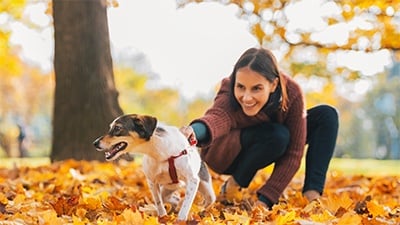
You can switch roles with your helper each time if you'd like. If your dog is distracted by the helper and doesn't show a lot of interest in running towards you, don't run too far away before calling them to come.
Do what you need to do to make yourself more exciting than your helper, and don't give up until your dog comes to you!
The more you play this game, the more you should see your dog pulling against the helper's hold on the harness as you run away.
Center of the Universe
This game is excellent for recall practice and all-around focusing on you. Think of yourself as the center of the universe where your dog always has to return to. I often play this game with group class training clients at the beginning of class to help dogs focus on their handler and create a nice foundation for the come when called behavior.
- Have a clicker (or marker word) ready, along with training treats.
- Your dog can be on or off a leash (as long as you're in a secure area).
- Toss a treat away from you for your dog, any direction is fine. Your dog should move to eat it.
- Once they've eaten that first treat, say their name.
- If they look at you or move towards you, click and toss another treat away from you in a different direction than the first.
- Use their name recognition or come cue to ask them to look at you or come towards you after each treat toss.
As you keep playing, you'll see how fast your dog learns that you're the center of the universe! They should begin to automatically look at you and come back to you in between each treat toss, rather than waiting for the next cue.
To increase the difficulty of this game, start tossing your treats further and further away for your dog or play on leash around outdoor distractions.
Chase Me!
If you're a fan of sprints, this game is for you! Play this game outside in a fenced yard or with your dog on a long leash, so there's lots of room for you to run. This long leash is perfect for this game.
- Start by simply hanging out with your dog, staying close to them as they sniff or otherwise enjoy being outside.
- Out of the blue, turn and sprint away!
- Your dog should run after you, especially if you make enticing sounds or clap excitedly as you run.
- Before your dog catches up to you, stop and say "come!" and then have a party!
- Catch your breath and then take another out-of-the-blue sprint.
Chasing is fun for many dogs and is a type of playstyle for them. Take advantage of this to build up your dog's recall and strengthen your bond.
PRO TIP: If your dog gets extra excited during this game and starts to jump or nip at you, redirect that excitement to a fun tug toy! That way you can let them celebrate and reward them while also keeping their paws and puppy teeth off of you.
Test Your Dog's Come When Called Cue
After you've had some time to create the association between the word "come" and the action of returning to you, it's time to give your dog a little quiz.
There's no wrong answer to this quiz, so no pressure! It's just to get an idea if your pup has made the association between the word and the action.
Stand completely still while your dog is somewhere away from you. Say "come" just once. Your dog will either:
- Come: If they come to you, praise and treat. Have a party because your dog has made the association, and you can start to increase distance and distraction!
- Not Come: If they don't come when you call, that's okay! But you need to somehow get them to come to you so you can reward the behavior you asked for. Try not to repeat the word "come" (I know how hard it is to not want to repeat a cue for us humans). Clap your hands excitedly, make kissy noises, or shake a treat bag to encourage your dog to finish the cue. Then simply go back to building the association some more.
PRO TIP: When I'm training a dog to come when called, I do not call the dog to come unless I know I can make it happen if they don't initially respond. If you ask for it, it's gotta happen!
Otherwise, your dog might learn that the word "come" means nothing, and they don't need to do anything when they hear it.
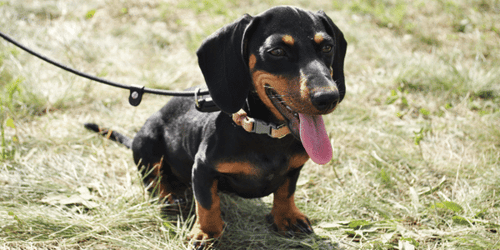 Structured Training Practice for Come When Called
Structured Training Practice for Come When Called
The majority of my recall training is focused on playing the games outlined above and capturing a dog's come in real-life situations.
However, practicing your dog's recall as a more structured training session can be very helpful, especially during the beginning stages or if you ever plan on participating in dog sports like competition obedience or Rally-O.
Your dog will need to have practiced their sit cue or down cue, and a basic stay before starting to train using this exercise.
Here's what a structured training session for come-when-called looks like:
- Ask your dog to sit or lie down.
- Ask them to stay.
- Walk a few steps away.
- Call them to "come."
- If they come running towards you, click as they complete the behavior, praise, and treat!
- Repeat!
If they don't move towards you in step 5, don't say "come" again! Instead, make kissy noises, pat your legs or entice them in some way to get them up and moving toward you. Click and treat when they get to you.
If your dog gets up but moves towards something else or in a different direction, interrupt them by guiding them back to their start point and into the sit or down position.
Then make the next step easier than before, perhaps only moving back one or two steps before calling to come, removing any distractions in the area, or practicing in a less distracting environment.
As you practice these steps, you can begin to add more distance between you and your dog before calling them to come and eventually practice in different places and around more distractions.
Go at your dog's pace so that each repetition is successful before adding distance or distractions.
Practicing Come-When-Called Around Distractions
Begin training your dog to come when called in an area that's not very distracting. This could be a hallway in your home or your family room. Once your dog is showing great responses to the cue in these areas, then begin to practice in a different place or by adding in distractions like toys, chews, family members, or your other dog to call them away from.
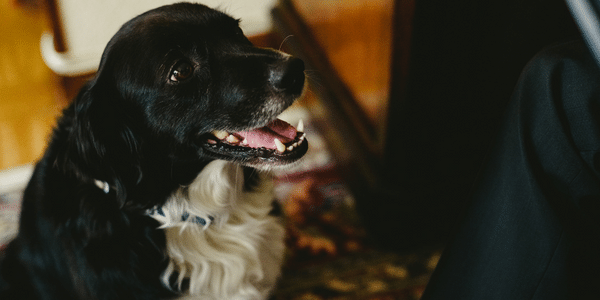
Where You Should Practice Your Dog's Recall
When you first start teaching your dog to come, set them up for success by beginning inside your home. I like to practice in long hallways since this really only gives your dog one choice as to which direction to run. But as their training progresses, you want to up the ante.
Then move on to calling them to come from a different room — coming when called when they can't see you is a big step! Make sure you have a solid foundation of the behavior, and that your dog truly understands what "come" means before expecting success outside or off-leash.
Then you can move on to practicing outdoors, whether that's in your yard or another secured area. Practicing recall can be tough in a group class environment with other people and dogs so close by, but is great for working around distractions.
While you're on your regular leashed walks, you can practice short-distance (but high-distraction) recalls when they notice a squirrel or another dog or person walking by. Here's an example of my dog Fozzie practicing his recall away from one of his human friends:
When you do start to add in longer distance recalls around distractions and in new environments, using a long leash is imperative for safety and control. I prefer these to just letting a dog drag their regular leash on the ground — if a dog takes off suddenly, you've got to be very quick to step on that shorter leash in time!
A long lead gives you a way to always be holding the leash, and make sure they can't dash into dangerous situations, like a busy road.
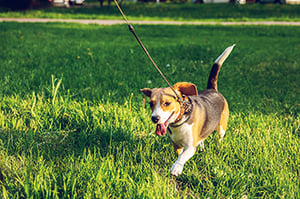 Practicing Outdoors
Practicing Outdoors
A big step in your dog's recall training is taking it outside. The great outdoors has so many distractions — most of them out of your control (squirrels, anyone?).
Even if you have a fenced yard, it's helpful to practice with your dog on a leash in that environment at first. That way, you can prevent them from taking off as they chase a bird instead of coming when called.
Make your first practice sessions around distractions super easy for your dog. Call them from short distances away. Call them to come before they get too distracted.
Reward them with higher-value treats than what they've been getting when practicing inside. Bring out a training toy that you usually keep hidden to reward them with tug.
Make the reward for coming when called better than usual when practicing around new distractions.
Here's a short video of one of my training clients practicing recall outside on a long leash at a local park. I love how excited she is when she gets back to her person.
Setting Your Dog Up For Reliable Recall Success
When NOT to Call Your Dog to Come
The last thing I want is for a dog to learn that the recall cue means nothing or is something they can just ignore in favor of chasing a squirrel. To prevent this, when I'm beginning to teach a dog to come when called, I never ask them to come if I can't somehow make it happen.
1. When Your Dog Simply Can't Hear You
If my dog has her nose buried in the grass, fully focused on whatever smell she found, I don't call her to come. Instead, if I need to get her back to me, I say her name first. If she orients towards me (sometimes even just an ear twitch in my direction), I know she can hear me, and then I call her to come. But if she's so engrossed in that smell, I simply walk closer to where I know she can hear me and respond to her come cue.
Your dog might be very far away when you want to ask them to come. Using a whistle is a great option for you if you know you'll need long-distance recalls. Some dog owners also add in an arm signal to their dog's recall if they know they will be working far away.
This movement should be something obvious and easy for your dog to see from a distance, such as an outstretched arm starting above your head and then dropping to your side. The one downside of having an arm signal for your dog's recall is that they need to be looking at you to see it. I prefer whistles for long-distance recalls for this reason.
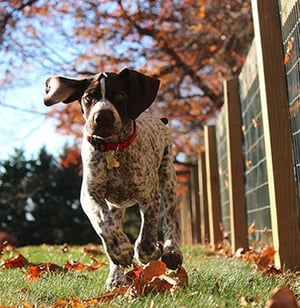
2. When You Haven't "Proofed" Your Dog's Recall
Don't call your dog to come when you know that you haven't proofed the behavior around that type of distraction. If your dog is playing with their buddies at the dog park and you've never practiced calling them away from play, don't say "come" and expect them to respond.
You don't want a failed cue. You also don't want to be that person that's chasing their dog around the park, yelling "come" over and over.
If you're still working on proofing your dog's recall, wait until there's a natural break in the play, get close to your dog, and then entice them towards you. This is the perfect opportunity to practice their recall around high distractions. Or simply and calmly collect them and go about your day.
I recommend training an emergency recall for your dog. This is an ultra-powerful recall cue that's trained a bit differently than a dog's regular come when called cue. Learn more in my article "How to Teach Your Dog an Emergency Recall."
3. When Coming Back to You Means They Lose Something They Like
Speaking of dog owners chasing their dog around the dog park ... many dogs don't respond to their recall cue when it's previously resulted in losing something they love. Leaving the dog park tends to be the most common example I see of this.
They know that when their person says "come!" at the dog park, they'll be put on their leash and then lose out on playtime. The same goes for dogs that love spending time out in the backyard. Their owner calls them to come, and they have to go inside.
Here's a way to prevent your dog from associating "come" with losing something they love:
- While playing at the dog park, call your dog to you frequently.
- Reward them each time.
- Release them back to play.
- Don't wait until you're leaving the dog park to call your dog to come. If 9 times out of 10 they get to return to the fun, they won't make the association that coming when called means they're leaving the park.
4. When You Need to Do Something Your Dog Doesn't Love
If you're about to do something that your dog doesn't enjoy at all, do not use your dog's recall cue. Instead, you have two options: go and collect your dog without saying come, or call them to come, reward, and then wait a few minutes before starting the less pleasant activity.
Here are some examples:
- Getting their nails trimmed
- Getting bathed
- Going in their crate (if they don't love their crate)
- Getting in the car (if they suffer from car sickness or travel anxiety)
I made this mistake with my last dog, Mikey. I worked at a dog daycare that also had a dog self-wash service. If I planned on washing him off after work, I would call him in from the yard and stand at the end of the hallway by the door that led to the bathing room.
It took two times for him to learn that if I called him to come while standing by that door, he was getting a bath. The next time I called him to come, he plopped down at the end of the hallway.
I learned my lesson! When I realized that I had created that association, I changed the routine. I practiced his recall in the hallway, and instead of getting a bath, he would get to hang out with me and get a yummy chew in the office for a while. Then I would put him on his leash and go bathe him. I had to change his association with coming when called in that particular context.
Be Exciting and Enticing!
The more engaged and excited you are during training, the more your dog will associate you with having fun — and are more likely to have a reliable recall! Movement can help entice your dog towards you, as well as using a variety of rewards while training.
You might even get down to your dog's level to encourage them to come running. Play around with what kinds of body movement and noises your dog responds well to, and incorporate that when starting to train your dog's recall.
How to Create a Faster Recall
We want our dogs to sprint back to us when we call them to come, not just saunter on back at a leisurely pace. You can encourage faster recalls a few different ways:
-
Be exciting! The more exciting and fun you are to your dog, the faster they'll return to you. If you're just standing still, there's no sense of urgency. Clap your hands or jog backward a few steps to encourage your dog to move faster towards you.
-
Hold them back. Play the Hold Me Back game outlined above in this article to increase recall speed.
-
Reward running. If you're using a clicker to train your dog's recall, you can begin only clicking for the repetitions where they're running. This should be done after you've taken the time to properly introduce the behavior, and your dog understands what "come" means.
-
Reward speed. If you're beginning to fade out the use of training treats in your dog's recall, use their recall speed to "grade" the response. Slow responses might only get praise or a low-value dog treat (like a piece of their regular kibble). Medium-speed responses might get a mid-value treat.
But if your dog comes sprinting back? That gets a high-value training reward like a piece of freeze-dried raw beef heart — something they only get for those fast responses! Grade A responses get Grade A treats. Read more about the different value of training treats and how to use them the right way when training your dog.
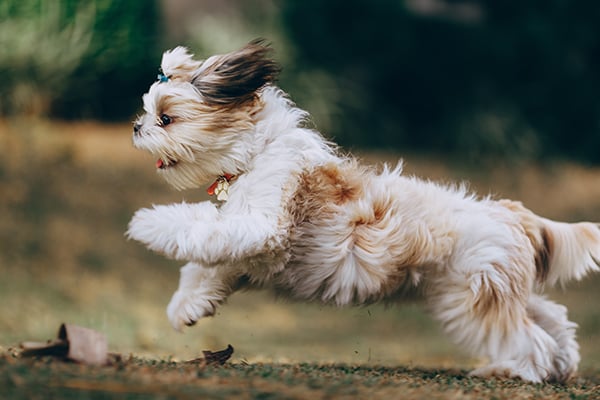
When is Your Dog Ready to be Off-Leash?
Consider if and when you should allow your dog to be off a leash in unsecured areas. If there are leash laws, please follow them for everyone's sake. Even if your dog is "friendly," other dogs on a leash might not react well to them approaching.
Many dogs become leash reactive and aggressive due to being overwhelmed by a "friendly" dog. You don't want your dog to be the cause of a dog fight.
Some people are afraid of dogs, and having an off-leash dog approaching is scary, no matter how many times you say, "Don't worry, they just want to say hi!" If your dog wants to greet everyone they see, being off-leash isn't the best idea unless you've taken the time to train a reliable recall and off-leash heel. Even though their intentions are good, it can backfire.
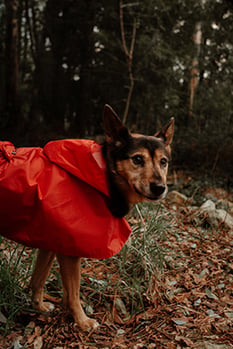 Hiking With Your Dog Off-Leash
Hiking With Your Dog Off-Leash
I tend to see many dogs hiking off-leash with their owners, and it can be a great experience! However, an off-leash dog can cause quite a ruckus with wildlife, destroy the natural fauna, and your dog might be injured if they wander off the trail and out of your sight.
Other hikers and on-leash dogs on the trail might not appreciate an off-leash dog running up to them either, for the reasons I explained above.
There's also the danger of ledges and sudden drops in terrain that you and your dog, who's running ahead of you, aren't aware of. Preventive Vet's CEO had both her dogs slide off a sandy-banked cliff over twenty years ago.
They were stranded on a 6x6 foot ledge some 100 feet down for over two hours. The experience of getting them back up was harrowing. Her story ended well, but others, unfortunately, don't.
If you plan on hiking with your dog off-leash, your dog must be able to recall away from chasing wildlife, greeting people, other dogs, or in our CEO's case, unknown territory. Incorporate lots of practice calling them away from distractions during your training.
Use a long leash on hikes so you can practice in that environment around those types of distractions. And while on hikes, your dog shouldn't be allowed to wander out of your sight. This way, you can make sure they stay safe and call them back to you if needed. Learn more in "Hiking With Your Dog: Preparation and Tips."
Practice on a Long Leash First
Before just unsnapping your dog's leash from their collar and finding out if they'll come back when called, practice using a long lead. These are dog leashes that are just longer lengths than the typical four or six-foot leash.
Using a long leash gives you the chance to practice your dog's recall from farther away and around distractions while still having a way to control them. It also feels more like being off-leash for your dog — there isn't any pressure or tension from a shorter lead.
Practice Off-Leash Recalls in Secure Areas
Take the time to practice an actual off-leash recall with your dog in securely fenced areas before allowing them off-leash freedom. This will give you an idea of where you're at in training and how well your dog responds. That way, you can go back a few steps in your dog's training and strengthen the foundation of your dog's recall if needed.
A great way to test an off-leash recall is at the dog park. There are lots of distractions, and they tend to be large spaces.
Make Sure Your Dog is Wearing ID and is Microchipped
Your dog should have an ID tag and be microchipped (make sure to keep the registration up-to-date!) if you do decide to allow them off-leash freedom. This way, if they do decide to go off on an adventure without you, there's a better chance that someone will be able to contact you quickly if they find them.
This is important all of the time, but especially during events like thunderstorms or fireworks when your dog could be scared and take off.
Read more about what you need to know before giving your dog off-leash freedom in our article "6 Tips for Taking Your Dog Off Leash."
How is your dog's come-when-called training going? Are they rock solid?
What distracts them the most when you call them to come? Let us know in the comments.


